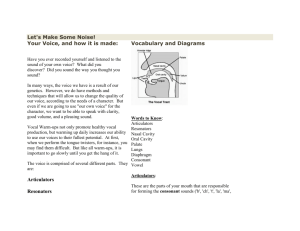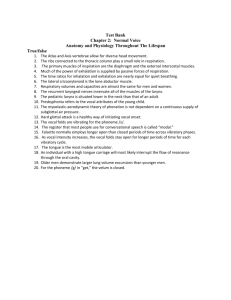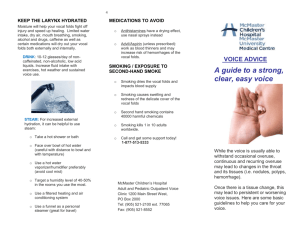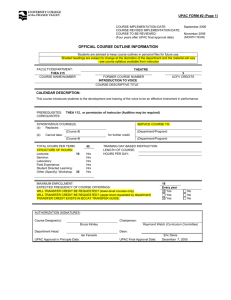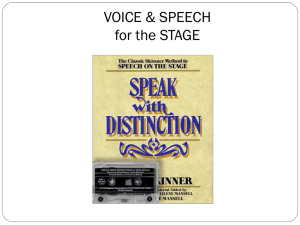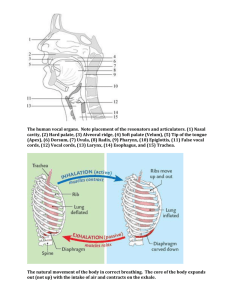1 From George Bernard Shaw's “Pygmalion”, “A Person's social
advertisement
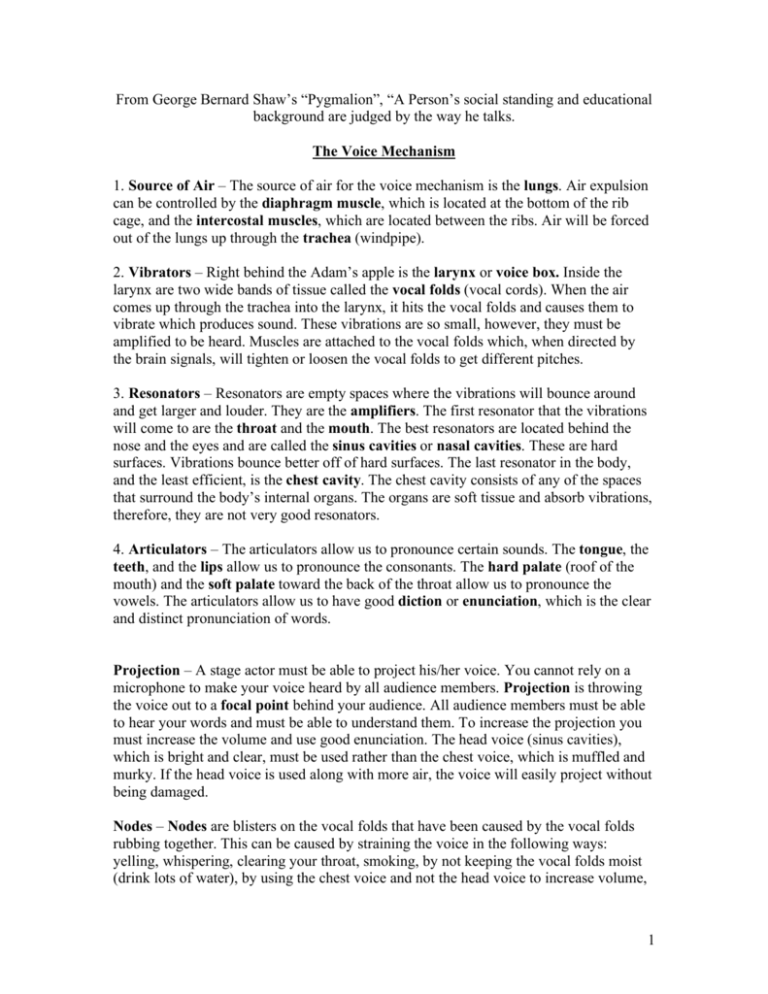
From George Bernard Shaw’s “Pygmalion”, “A Person’s social standing and educational background are judged by the way he talks. The Voice Mechanism 1. Source of Air – The source of air for the voice mechanism is the lungs. Air expulsion can be controlled by the diaphragm muscle, which is located at the bottom of the rib cage, and the intercostal muscles, which are located between the ribs. Air will be forced out of the lungs up through the trachea (windpipe). 2. Vibrators – Right behind the Adam’s apple is the larynx or voice box. Inside the larynx are two wide bands of tissue called the vocal folds (vocal cords). When the air comes up through the trachea into the larynx, it hits the vocal folds and causes them to vibrate which produces sound. These vibrations are so small, however, they must be amplified to be heard. Muscles are attached to the vocal folds which, when directed by the brain signals, will tighten or loosen the vocal folds to get different pitches. 3. Resonators – Resonators are empty spaces where the vibrations will bounce around and get larger and louder. They are the amplifiers. The first resonator that the vibrations will come to are the throat and the mouth. The best resonators are located behind the nose and the eyes and are called the sinus cavities or nasal cavities. These are hard surfaces. Vibrations bounce better off of hard surfaces. The last resonator in the body, and the least efficient, is the chest cavity. The chest cavity consists of any of the spaces that surround the body’s internal organs. The organs are soft tissue and absorb vibrations, therefore, they are not very good resonators. 4. Articulators – The articulators allow us to pronounce certain sounds. The tongue, the teeth, and the lips allow us to pronounce the consonants. The hard palate (roof of the mouth) and the soft palate toward the back of the throat allow us to pronounce the vowels. The articulators allow us to have good diction or enunciation, which is the clear and distinct pronunciation of words. Projection – A stage actor must be able to project his/her voice. You cannot rely on a microphone to make your voice heard by all audience members. Projection is throwing the voice out to a focal point behind your audience. All audience members must be able to hear your words and must be able to understand them. To increase the projection you must increase the volume and use good enunciation. The head voice (sinus cavities), which is bright and clear, must be used rather than the chest voice, which is muffled and murky. If the head voice is used along with more air, the voice will easily project without being damaged. Nodes – Nodes are blisters on the vocal folds that have been caused by the vocal folds rubbing together. This can be caused by straining the voice in the following ways: yelling, whispering, clearing your throat, smoking, by not keeping the vocal folds moist (drink lots of water), by using the chest voice and not the head voice to increase volume, 1 and by not using a sufficient amount of air. Mild cases of nodes may go away by themselves with proper care, however, severe cases of nodes can only be removed by surgery which will then leave scar tissue on the vocal folds. They can no longer vibrate properly. Four Characteristics of the Voice A. Quality – the individual sound of your particular voice. B. Pitch – the highness or lowness of a voice at any given time. Inflection is a variety in pitch to show emotion or to emphasize a word or thought. A rising inflection shows incompleteness of thought or uncertainty. It is often used in asking a question. Monotony is not changing pitch at all. This will not hold an audience’s attention. Pitch exercises: 1. Count from 1-10 starting as low as you can and going as high as you can without strain. Then reverse. 2. Count slowly from 1-10 giving the vowel in each number a long falling inflection. Repeat with a long rising inflection on each number; then alternate. 3. Read these sentences with the widest possible range. Put emphasis on the important words and syllables by raising the pitch. Definitely drop on unimportant words. a. What a glorious sunset! b. To speak effectively you must raise your voice on the important words. c. In direct conversation we change the pitch of the voice constantly. d. Did you hear what I said? Then go! e. No, I will not go! f. Look, that plane is exploding! g. I shall never, never, never believe you again! C. Volume – the relative strength, force or intensity with which the sound is made. There are two types of force. Strong emotions use explosive force (sudden, sharp breath pressure). When breath pressure is held steady and breath is released gradually, the force is expulsive (reading long passages without loss of breath). Always keep the person who is farthest from you constantly in mind and talk directly to him. You can clarify or change the meaning of a sentence by shifting the force from one word to another. Do you like coffee? How are you? I didn’t say that to her. You don’t think I stole the book, do you? Why didn’t you warn me before it happened? D. Rate – the speed at which words are spoken. The rate is usually more rapid in informal conversation than in public speaking. Rate can also suggest ideas and emotional states. Steadily increasing the speed creates a feeling of tension and excitement, while deliberate delivery impresses the listener with the significance of the words. You must 2 breathe between thought groups. Punctuation is of the utmost importance in establishing thought groups. Don’t run words or ideas together. Sounding the ending consonants is very important. The effective voice depends on body relaxation and good posture. There is a very close relation between the voice, the body and emotions. Breath control determines the carrying power of your voice. Inhale through the mouth, not the nose. Prolonged, controlled exhalation is needed for sustained vocal tone. Deep, relaxed breathing exercises: 1. With hands on your waist, stand straight with easy, well-balanced posture. Inhale slowly. Hold your breath for a count of six and then exhale slowly (hissing) while counting to 15, then 20, then 25, etc. Do not raise your shoulders. 2. With the same stance as number one, see how far you can get reciting a poem or nursery rhyme in one breath. 3. Lie flat on your back and place one hand on your stomach. Inhale and exhale normally. Recite the alphabet by taking a breath for each letter. Then, see how far you can slowly recite in one breath. 4. Pant like a dog. Feel the movement of the diaphragm muscle with your hands. Then say “ha, ha” as you pant. 5. Say “Mary had a little lamb” nursery rhyme and then “Twinkle, twinkle little star” twice in one breath slowly. 4. Relaxation exercises on pp. 156-159 (The Stage and The School). Your voice mechanism involves the use of many muscles. Like an athlete, you must warm up the muscles of the voice before using to avoid damaging the muscles. There are several vocal warm-ups that can be used to warm up the muscles and to practice diction at the same time. Yawning is one of the best voice exercises for relaxation. (It also helps to cure stage fright.) Tongue twisters are very good warm-ups. Make sure you are using plenty of air to support the vibrations and enunciating clearly. Try to speak slowly! Repeat each one three times in a row. Sister Susie’s sewing socks for soldiers. She sells sea shells by the seashore. Rubber baby buggy bumpers. Toy boat. Peter Piper picked a peck of pickled peppers. Billy Button bought a buttered biscuit. Selfish shellfish. 3 Knapsack straps. Unique New York. Black bug’s blood. Fresh fried fish. Lemon liniment. Red leather, yellow leather. Specific Pacific. Men munch much mush. Good blood, bad blood. Fruit float. Thieves seize skis. Slippery southern snakes slide swiftly down ski slopes. Wee Willy whistles to wise Wilber Whale. A real red rooster roosts in the rain. Beautiful brooks babble between blossoming banks. Ten terrified tomcats tottering in the tops of three tall trees. The sixth sheik’s sixth sheep is sick. Betty beat a bit of butter to make a better batter. A box of biscuits, a box of mixed biscuits, and a biscuit mixer. Greasy Granny grasped the great gray goose. A pale pink proud peacock pompously preened its pretty plumage. This is a zither. Is this a zither? Enunciation (articulation) exercises: 1. practice the front, middle and back vowel sounds: a. feel, fill, fell, fall, fail, file, foil, foul b. tea, tin, ten tan, ton, turn, tarn, torn, tune town c. eat, it, at, ought, ate d. peak, pick, peck, pack, puck, perk, park, pock, pork, poke, pike 2. practice the different consonant sounds and be aware of what articulators are being used: a. pen, Ben, ten, den, ken, fen, when,wen b. have, cat, gap, quack, land, nag, tap, dash, rat, map, pat, bat, fat, vat, thank c. than, sad, sham, chap, jam, plaid, black, flat, slack, clan, glad, snack, stand d. smack, span, scan, tap, dram, prank, bran, frank, crab, grab, thrash shrapnel e. strap, sprat, scrap, splash, swam, twang, wag, yap f. hood, could, good, look, nook, put, book, foot soot, should, brook, crook, wood 3. practice sentences on page 187 ( The Stage and The School) 4. Practice phrase combinations that are often run together: a. Didn’t you? - Didncha? b. Wouldn’t you? c. Haven’t you? d. Shouldn’t you? e. Why don’t you? 4 5. Practice words ending in “ing”, “d” and “t”. Avoid replacing “t’s” in the middle of a word with “d’s”, e.g., butter, later, latter, mutter, utter, etc. Vocal Exercises: 1. Tell the story of the bears stressing the vocal characteristics of each character. 2. Say “oh” to suggest the following: keen interest, sudden pain, deep sympathy, utter exhaustion, delight, fear, irritation, anger, sarcasm, hesitation, embarrassment, horror, surprise. 3. Recite “Mary Had a Little Lamb” in the following ways: suspensefully nervously as a rock song very loudly angrily in a depressed manner happily like a TV newscaster sadly very softly in an operatic voice weeping Mary had a little lamb. Its fleece was white as snow. And everywhere that Mary went, The lamb was sure to go. 4. Repeat the following words saying them with as much expression as possible in the voice and the face, reflecting the actual meaning of the word. Cold Freezing Nervous Gentle Tender angry mad depressed shivering mean harsh sweltering calm grim bubbly warm glad giggly parched afraid happy sad weeping relaxed shocked soft tense laughing stern irritated 5
